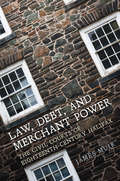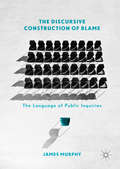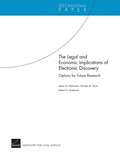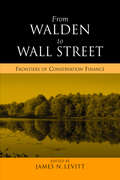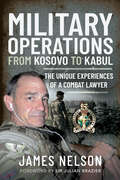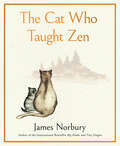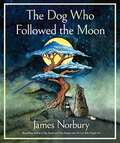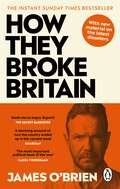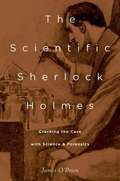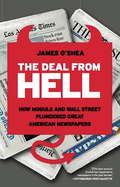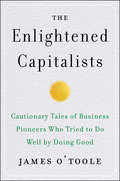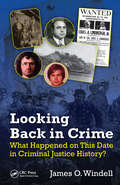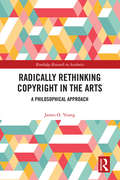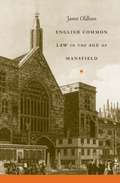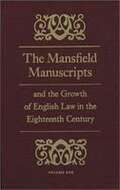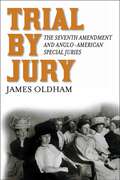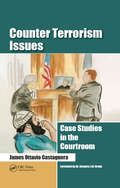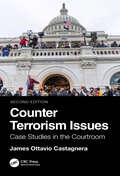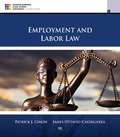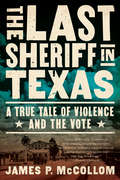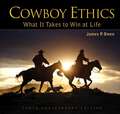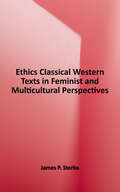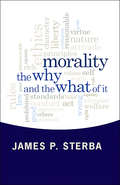- Table View
- List View
Law, Debt, and Merchant Power: The Civil Courts of 18th Century Halifax
by The Osgoode Society James MuirIn the early history of Halifax (1749-1766), debt litigation was extremely common. People from all classes frequently used litigation and its use in private matters was higher than almost all places in the British Empire in the 18th century. In Law, Debt, and Merchant Power, James Muir offers an extensive analysis of the civil cases of the time as well as the reasons behind their frequency. Muir's lively and detailed account of the individuals involved in litigation reveals a paradoxical society where debtors were also debt-collectors. Law, Debt, and Merchant Power demonstrates how important the law was for people in their business affairs and how they shaped it for their own ends.
The Discursive Construction of Blame: The Language of Public Inquiries
by James MurphyThis book examines the language of public inquiries to reveal how blame is assigned, avoided, negotiated and discussed in this quasi-legal setting. In doing so, the author adds a much-needed linguistic perspective to the study of blame – previously the reserve of moral philosophers, sociologists and psychologists – at a time when public inquiries are being convened with increasing frequency. While the stated purpose of a public inquiry is rarely to apportion blame, this work reveals how blame is nevertheless woven into the fabric of the activity and how it is constructed by the language of the participants. Its chapters systematically analyse the establishment of inquiries, their questioning patterns, how blame can be avoided by witnesses, how blame is assigned or not by an inquiry’s panel and how such blame may result in public apologies. The author concludes with an engaging discussion on the value of public inquiries in civic life and suggestions for changes to the processes of public inquiries. This book will appeal to readers with a general interest in public and political language; in addition to scholars across the disciplines of communication, media studies, politics, sociology, social policy, philosophy, psychology, linguistics, rhetoric, public relations and public affairs.
The Legal and Economic Implications of Electronic Discovery
by James N. Dertouzos Robert H. Anderson Nicholas M. PaceThe growing volume of electronically stored information has led to concerns that requests for electronic discovery (e-discovery) can increase litigation costs, impose new risks on lawyers and their clients, and alter expectations about likely court outcomes. The authors provide an overview of the issues involved and outline five avenues for future research on the legal and economic implications of e-discovery.
From Walden to Wall Street: Frontiers of Conservation Finance
by James N. Levitt"From Walden to Wall Street makes clear that a system of market-based conservation finance is vital to the future of environmental conservation." -Henry M. Paulson, Chairman and CEO, Goldman Sachs Group, Inc.; Chairman of the Board of Governors, The Nature Conservancy In the absence of innovation in the field of conservation finance, a daunting funding gap faces conservationists aiming to protect America's system of landscapes that provide sustainable resources, water, wildlife habitat, and recreational amenities. Experts estimate that the average annual funding gap will be between $1.9 billion and $7.7 billion over the next forty years. Can the conservation community come up with new methods for financing that will fill this enormous gap? Which human and financial resources will allow us to fund critical land conservation needs? From Walden to Wall Street brings together the experience of more than a dozen pioneering conservation finance practitioners to address these crucial issues. Contributors present groundbreaking ideas including mainstreaming environmental markets; government ballot measures for land conservations; convertible tax-exempt financing; and private equity markets. The creativity and insight of From Walden to Wall Street offers considerable hope that, even in this era of widespread financial constraints, the American conservation community's financial resources may potentially grow dramatically in both quantity and quality in the decades to come.
Military Operations from Kosovo to Kabul: The Unique Experiences of a Combat Lawyer
by James NelsonIn this highly unusual role for a lawyer, the author found himself in 1998 having to learn on his feet at a frightening pace as the newly promoted senior legal advisor to the charismatic General Sir Mike Jackson, the commander who led the Allied Rapid Reaction Corps into strife-torn Kosovo the following year to restore some sort of normality in the aftermath of the NATO bombing campaign. A peace deal was finally signed, only for Russia to intervene at the eleventh hour. The author was asked to provide rules of engagement for NATO to eject a stubborn Russian unit from Pristina by force, amongst fears of starting World War III, one of the few occasions when he thought perhaps civilian legal practice might not have been such a bad idea after all. Ten years later the author was back at HQ ARRC, promoted to Colonel. The culture shock on this occasion was not so much, spending six months in Afghanistan as being professionally embedded in a large American military legal office led by a hyper energetic US officer from the 'deep south'. Unlike the short, sharp Kosovo experience in central Europe, this war in central Asia was the longest in the history of the USA, although for the British it was just the latest in a succession of operations going back two centuries to the 'Great Game'. Trying to apply the law, balancing the need for aggression with compliance with Western notions of human rights, and vain efforts to win over the hearts and minds of a proud but impoverished people historically blighted by conflict proved to be unimaginably fraught. Military Operations From Kosovo to Kabul is one experienced soldier’s fascinating account of these historic events, seen on the ground from the perspective of a legal professional, seldom associated with fighting wars.
The Cat Who Taught Zen EBP
by James NorburyFrom the author and illustrator of the international bestseller Big Panda and Tiny Dragon comes a beautifully illustrated exploration into the journeys we take for self-discovery and the connections we make along the way.In a distant city, an old cat considers himself as wise as can be, until he hears of an ancient pine far away, under the boughs of which infinite wisdom can be found. Thus, the Cat embarks on a journey deep into the forest to search for the tree. Along the way, he meets new friends—the Hare, the Magpie, the Wolf Cub, the Monkey, the Tortoise, and the Tiger—and comes across the energetic young Kitten. What wisdom does the Cat have to impart to his friends, and, perhaps more importantly, what does he still have to learn?Inspired by Zen koans, with stunning illustrations and a gentle voice, The Cat Who Taught Zen has wisdom to offer all readers.
The Dog Who Followed the Moon
by James NorburyFrom the international bestselling author and illustrator of Big Panda and Tiny Dragon and The Cat Who Taught Zen comes a beautifully illustrated adult fable of a lost young puppy, the old wolf who rescues her, and their journey to follow the moon—with meditations on friendship, connection, and sacrifice.Deep in the mountain forests, a young pup named Amaya wanders lost and alone, until an aging wolf rescues her from a terrifying encounter with his vicious pack. To try and reunite Amaya with her parents, the unlikely pair embark on a journey to follow the moon.Eerie woods, forgotten cities, and other obstacles await Amaya and the Wolf on their adventure. As they make their way through the wilderness, the two learn profound lessons about love, sacrifice, and the importance of embracing change.Featuring stunning artwork from bestselling author and illustrator James Norbury, The Dog Who Followed the Moon is a moving, poignant reflection on love and loss, grief and growth.
How They Broke Britain: The Instant Sunday Times Bestseller
by James O'Brien***THE RUNAWAY BESTSELLER, WITH NEW MATERIAL FOR THE PAPERBACK***THE REVEALING, DEFINING ACCOUNT OF THE DARK NETWORK THAT BROKE OUR COUNTRY.Something has gone really wrong in Britain.Our economy has tanked, our freedoms are shrinking, and social divisions are growing. Our politicians seem most interested in their own careers, and much of the media only make things worse. We are living in a country almost unrecognisable from the one that existed a decade ago. But whose fault is it really? Who broke Britain and how did they do it?Bold and incisive as ever, James O'Brien reveals the shady network of influence that has created a broken Britain of strikes, shortages and scandals. He maps the web connecting dark think tanks to Downing Street, the journalists involved in selling it to the public and the media bosses pushing their own agendas. Over ten chapters, each focusing on a particular person complicit in the downfall, James O'Brien reveals how a select few have conspired - sometimes by incompetence, sometimes by design - to bring Britain to its knees.
The Scientific Sherlock Holmes: Cracking the Case With Science and Forensics
by James O'BrienOne of the most popular and widely known characters in all of fiction, Sherlock Holmes has an enduring appeal based largely on his uncanny ability to make the most remarkable deductions from the most mundane facts. The very first words that Sherlock Holmes ever says to Dr. Watson are, "How are you? You have been in Afghanistan, I perceive. " Watson responds, "How on earth did you know that?" And so a crime-solving legend is born. In The Scientific Sherlock Holmes, James O'Brien provides an in-depth look at Holmes's use of science in his investigations. Indeed, one reason for Holmes's appeal is his frequent use of the scientific method and the vast scientific knowledge which he drew upon to solve mysteries. For instance, in heart of the book, the author reveals that Holmes was a pioneer of forensic science, making use of fingerprinting well before Scotland Yard itself had adopted the method. One of the more appealing aspects of the book is how the author includes real-world background on topics such as handwriting analysis, describing how it was used to capture the New York Zodiac killer and to clinch the case against the Lindbergh baby kidnapper. Sherlock Holmes was knowledgeable about several sciences, most notably chemistry. Therefore the book takes a close look at Holmes the chemist and discusses, for example, chemical poisons such as carbon monoxide, chloroform, and Prussic acid (the historical name for hydrogen cyanide). The author also debunks Isaac Asimov's famous assertion that Holmes was a blundering chemist. In addition, the book discusses mathematics, physics, biology, astronomy, meteorology, and geology, always in the context of Holmes's exploits. Sherlock Holmes continues to fascinate millions of readers and movie goers alike. The Scientific Sherlock Holmes is a must-read for the legion of fans of this most beloved of all fictional detectives.
The Deal from Hell: How Moguls and Wall Street Plundered Great American Newspapers
by James O'SheaIn 2000, after the Tribune Company acquired Times Mirror Corporation, it comprised the most powerful collection of newspapers in the world. How then did Tribune nosedive into bankruptcy and public scandal? In The Deal From Hell, veteran Tribune and Los Angeles Times editor James O'Shea takes us behind the scenes of the decisions that led to disaster in boardrooms and newsrooms from coast to coast, based on access to key players, court testimony, and sworn depositions.The Deal From Hell is a riveting narrative that chronicles how news industry executives and editors--convinced they were acting in the best interests of their publications--made a series of flawed decisions that endangered journalistic credibility and drove the newspapers, already confronting a perfect storm of political, technological, economic, and social turmoil, to the brink of extinction.
The Enlightened Capitalists: Cautionary Tales of Business Pioneers Who Tried to Do Well by Doing Good
by James O'TooleAn expert on ethical leadership analyzes the complicated history of business people who tried to marry the pursuit of profits with virtuous organizational practices—from British industrialist Robert Owen to American retailer John Cash Penney and jeans maker Levi Strauss to such modern-day entrepreneurs Anita Roddick and Tom Chappell. <P><P>Today’s business leaders are increasingly pressured by citizens, consumers, and government officials to address urgent social and environmental issues. Although some corporate executives remain deaf to such calls, over the last two centuries, a handful of business leaders in America and Britain have attempted to create business organizations that were both profitable and socially responsible. In The Enlightened Capitalists, James O’Toole tells the largely forgotten stories of men and women who adopted forward-thinking business practices designed to serve the needs of their employees, customers, communities, and the natural environment. They wanted to prove that executives didn’t have to make trade-offs between profit and virtue. <P><P>Combining a wealth of research and vivid storytelling, O’Toole brings life to historical figures like William Lever, the inventor of bar soap who created the most profitable company in Britain and used his money to greatly improve the lives of his workers and their families. Eventually, he lost control of the company to creditors who promptly terminated the enlightened practices he had initiated—the fate of many idealistic capitalists. <P><P>As a new generation attempts to address social problems through enlightened organizational leadership, O’Toole explores a major question being posed today in Britain and America: Are virtuous corporate practices compatible with shareholder capitalism?
Religious Doctrines and their Influence on Entrepreneurship
by James O. FietThis book explores how religious doctrines influence launching a new venture. It examines 16 Christian denominations and 9 world religions and how they would reasonably be expected to apply more than 20 distinct doctrines each to entrepreneurship. It is not an examination of doctrinal veracity because adherents have confidence in their beliefs. Rather, it examines how they will evaluate the attractiveness of entrepreneurship through the lenses of their beliefs, assuming they receive what they expect. More than 100 years ago, Max Weber pitted Protestantism against Hinduism in a single hypothesis. The current study is a multifactorial examination that covers the world’s major religions, as well as most of their doctrines. It is the first comprehensive examination of how entrepreneurs view the world through the lenses of their religious doctrines, which represent the formalization of their most deeply held beliefs.
Looking Back in Crime: What Happened on This Date in Criminal Justice History?
by James O. WindellJust as people are captivated by murder mysteries, detective stories, and legal shows, they are also compulsively interested in the history of criminal justice. Looking Back in Crime: What Happened on This Day in Criminal Justice History? features a treasure trove of important dates and significant events in criminal justice history.Offering hundre
Radically Rethinking Copyright in the Arts: A Philosophical Approach (Routledge Research in Aesthetics)
by James O. YoungThis book radically rethinks the philosophical basis of copyright in the arts. The author reflects on the ontology of art to argue that current copyright laws cannot be justified. The book begins by identifying two problems that result from current copyright laws: (1) creativity is restricted and (2) they primarily serve the interests of large corporations over those of the artists and general public. Against this background, the author presents an account of the ontology of artworks and explains what metaphysics can tell us about ownership in the arts. Next, he makes a moral argument that copyright terms should be shorter and that corporations should not own copyrights. The remaining chapters tackle questions regarding the appropriation of tokens of artworks, pattern types, and artistic elements. The result is a sweeping reinterpretation of copyright in the arts that rests on sound ontological and moral foundations. Radically Rethinking Copyright in the Arts will be of interest to scholars and advanced students working in aesthetics and philosophy of art, metaphysics, philosophy of law, and intellectual property law.
English Common Law in the Age of Mansfield
by James OldhamIn the eighteenth century, the English common law courts laid the foundation that continues to support present-day Anglo-American law. Lord Mansfield, Chief Justice of the Court of King's Bench, 1756-1788, was the dominant judicial force behind these developments. In this abridgment of his two-volume book, The Mansfield Manuscripts and the Growth of English Law in the Eighteenth Century, James Oldham presents the fundamentals of the English common law during this period, with a detailed description of the operational features of the common law courts. This work includes revised and updated versions of the historical and analytical essays that introduced the case transcriptions in the original volumes, with each chapter focusing on a different aspect of the law.While considerable scholarship has been devoted to the eighteenth-century English criminal trial, little attention has been given to the civil side. This book helps to fill that gap, providing an understanding of the principal body of substantive law with which America's founding fathers would have been familiar. It is an invaluable reference for practicing lawyers, scholars, and students of Anglo-American legal history.
The Mansfield Manuscripts and the Growth of English Law in the Eighteenth Century (Studies in Legal History #Vol. 1)
by James OldhamUsing voluminous trial notes and previously unexplored documents, Oldham provides a reappraisal of the judicial career of Lord Mansfield, chief justice of the Court of King's Bench in England from 1756 to 1799. <p><p> In this two-volume work, he presents important biographical information about Mansfield and brings to life the context, personalities, and operational features of the Court of King's Bench during the eighteenth century.
The Mansfield Manuscripts and the Growth of English Law in the Eighteenth Century (Studies in Legal History #Vol. 2)
by James OldhamUsing voluminous trial notes and previously unexplored documents, Oldham provides a reappraisal of the judicial career of Lord Mansfield, chief justice of the Court of King's Bench in England from 1756 to 1799. <p><p> In this two-volume work, he presents important biographical information about Mansfield and brings to life the context, personalities, and operational features of the Court of King's Bench during the eighteenth century.
Trial by Jury: The Seventh Amendment and Anglo-American Special Juries
by James OldhamWhile the right to be judged by one's peers in a court of law appears to be a hallmark of American law, protected in civil cases by the Seventh Amendment to the Constitution, the civil jury is actually an import from England. Legal historian James Oldham assembles a mix of his signature essays and new work on the history of jury trial, tracing how trial by jury was transplanted to America and preserved in the Constitution.Trial by Jury begins with a rigorous examination of English civil jury practices in the late eighteenth century, including how judges determined one's right to trial by jury and who composed the jury. Oldham then considers the extensive historical use of a variety of “special juries,” such as juries of merchants for commercial cases and juries of women for claims of pregnancy. Special juries were used for centuries in both English and American law, although they are now considered antithetical to the idea that American juries should be drawn from jury pools that reflect reasonable cross-sections of their communities. An introductory overview addresses the relevance of Anglo-American legal tradition and history in understanding America's modern jury system.
Counter Terrorism Issues: Case Studies in the Courtroom
by James Ottavio CastagneraThe American legal profession and judicial system bear a unique responsibility to set and maintain the balance between defending homeland security and protecting the civil liberties outlined in the Bill of Rights. These competing interests will continue to collide as the threats to our safety grow. Exploring the most significant terrorist cases of
Counter Terrorism Issues: Case Studies in the Courtroom
by James Ottavio CastagneraCounter Terrorism Issues: Case Studies in the Courtroom, Second Edition presents a panoramic view of the American judiciary’s handling of domestic terrorism in the last 30 years. As has played out in recent history, the American legal profession and judicial system bear a unique responsibility to set and maintain the balance between defending homeland security and protecting the civil liberties outlined in the Bill of Rights. These competing interests will continue to collide as the threats to our safety grow.The book examines some of the most notorious cases—the two attacks on the World Trade Center, the Oklahoma City bombing, and the Fort Hood massacre. Updates from the First Edition include a reflection on the Boston Marathon bombing, as well as an examination of the events of January 6, 2021, the subsequent legal proceedings and convictions of those involved in the assault on the U.S. Capitol, and the danger arising from increased domestic extremism and violent rhetoric from the right.Drawing extensively upon trial transcripts, witness statements, and judicial opinions, the book reviews the events and cases to demonstrate how the criminal justice system has grappled with conflicting facts and countervailing legal rights and responsibilities. Through the words of witnesses, judges, and the attorneys who tried these cases in America’s courtrooms, coverage provides important commentary on the historical/political contexts of these events, enabling readers to understand the significance of these infamous attacks on U.S. soil.
Employment and Labor Law (9th Edition)
by Patrick J. Cihon James Ottavio CastagneraThinking about a Human Resources career after you graduate? Employment and Labor Law is written for you, the non-legal professional, and contains all you need to know to prepare for any labor situation in the corporate world. Inside you'll find the latest information on federal and state employment laws and read real-world cases that clarify the material.
The Last Sheriff in Texas: A True Tale of Violence and the Vote
by James P. McCollom"[A] narrative with resonance well beyond seekers of Texas history. The Last Sheriff in Texas would be an amazing allegory for our times, were it fiction. Instead it suggests cultural trenches that we view as new that were dug decades ago." —Houston ChronicleBeeville, Texas, was the most American of small towns—the place that GIs had fantasized about while fighting through the ruins of Europe, a place of good schools, clean streets, and churches. Old West justice ruled, as evidenced by a 1947 shootout when outlaws surprised popular sheriff Vail Ennis at a gas station and shot him five times, point–blank, in the belly. Ennis managed to draw his gun and put three bullets in each assailant; he reloaded and shot them three times more.Time magazine&’s full–page article on the shooting was seen by some as a referendum on law enforcement owing to the sheriff&’s extreme violence, but supportive telegrams from all across America poured into Beeville&’s tiny post office. Yet when a second violent incident threw Ennis into the crosshairs of public opinion once again, the uprising was orchestrated by an unlikely figure: his close friend and Beeville&’s favorite son, Johnny Barnhart.Barnhart confronted Ennis in the election of 1952: a landmark standoff between old Texas, with its culture of cowboy bravery and violence, and urban Texas, with its lawyers, oil institutions, and a growing Mexican population. The town would never be the same again.The Last Sheriff in Texas is a riveting narrative about the postwar American landscape, an era grappling with the same issues we continue to face today. Debate over excessive force in law enforcement, Anglo–Mexican relations, gun control, the influence of the media, urban–rural conflict, the power of the oil industry, mistrust of politicians and the political process—all have surprising historical precedence in the story of Vail Ennis and Johnny Barnhart.
Cowboy Ethics: What It Takes to Win at Life
by James P. OwenA new approach to business ethics is quietly taking hold in executive suites and corporate boardrooms across America. Frustrated by an epidemic of misbehavior at all employee levels, management teams are getting back to basics-back to the idea that personal character and individual responsibility are the ultimate keys to integrity, just as they were back in the days of the Open Range.A decade ago, the book Cowboy Ethics first inspired businesspeople to look to the Code of the West. Once they did, they discovered that its simple, common-sense principles can be more effective guides to business leadership than a truckload of corporate mission statements, rules, and ethics manuals. "Cowboys are role models because they live by a code," says author James P. Owen. "They show us what it means to stand for something, and to strive every day to make your actions line up with your beliefs. And isn't that as good a definition of integrity as you can find?" In the years since, the book's "Ten Principles to Live By" have been embraced by scores of companies, universities, and even a state government. This updated Tenth Anniversary hardcover edition traces the evolution of this grassroots business movement in brand-new chapters while preserving the inspirational lessons and stunning photography of the original. It's ideal for corporate gifts, the new graduate, business students, or any career person who cares about doing the right thing.
Ethics: Classical Western Texts in Feminist and Multicultural Perspectives
by James P. SterbaEthics: Classical Western Texts in Feminist and Multicultural Perspectives offers students a unique introduction to ethics by integrating the historical development of Western moral philosophy with both feminist and multicultural approaches. Engaging and accessible, it provides an introductory sampling of several of the classical works of the Western tradition in ethics and then situates these readings within feminist and multicultural perspectives to better understand and evaluate them in our contemporary environment. While some of the non-Western works parallel the views defended in the Western works (e.g., Confucius's work echoes that of Plato or Aristotle), others question the Western perspectives (e.g., American Indian works provide an interesting challenge to Western moral philosophy). Confucius, Jorge Valadez, Ward Churchill, Moshoeshoe II, and Eagle Man present multicultural perspectives to the works of Plato, Aristotle, Hume, Kant, Nietzsche, Sartre, Rawls, MacIntyre, Korsgaard, and others. Noted feminists Christine de Pizan, Simone de Beauvoir, Carol Gilligan, Annette Baier, Susan Okin, and Rosemarie Radford Ruether also offer alternative views. Ideal for courses in introduction to ethics, history of ethics, and feminist ethics, the book is also intriguing reading for interested general readers.
Morality
by James P. SterbaThis collection of essays examines what morality requires of us and why we should even be moral. They are organized around Sterba's opening essay, which attempts to answer these questions by first of all arguing that we must be moral because we are rationally compelled, but by also advancing a number of positions from a libertarian perspective about egotism and altruism, negative liberty, welfare and equality. Each of essays not written by Sterba critiques a facet of his argument. They focus mostly on the rational underpinning of morality; moral skepticism; egotism, altruism and social cooperation; and how libertarianism does not lead to welfare and equality. Sterba responds to these critiques in a final essay. The other authors are professors of philosophy with specialties in moral thinking. Annotation ©2012 Book News, Inc. , Portland, OR (booknews. com)
